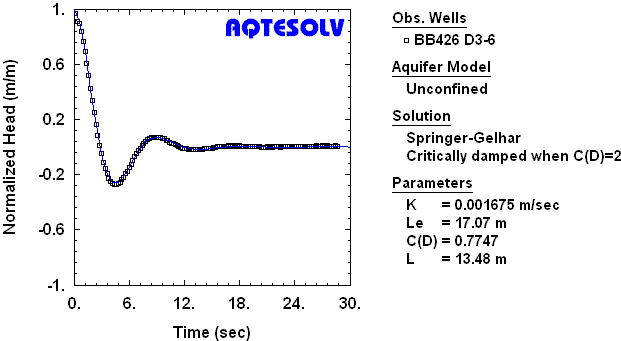Springer and Gelhar Slug Test Solution for Unconfined Aquifers
Related Solution Methods
Additional Topics

A mathematical solution by Springer and Gelhar (1991) is used to determine the hydraulic conductivity of unconfined aquifers. The method accounts for inertial effects in the well and oscillatory slug test response in a high-hydraulic conductivity (high-K) aquifer. Analysis involves matching a type-curve solution to water-level displacement data collected during an underdamped slug test. The Springer and Gelhar solution also incorporates frictional well loss in small-diameter wells (Butler 2002).
AQTESOLV provides visual and automatic methods for matching the Springer and Gelhar solution to slug test data. This easy-to-use and intuitive software promotes rapid and accurate determination of aquifer properties.
Assumptions
The following assumptions apply to the use of the Springer and Gelhar slug test solution:
- aquifer has infinite areal extent
- aquifer is homogeneous and of uniform thickness
- aquifer potentiometric surface is initially horizontal
- control well is fully or partially penetrating
- a volume of water, V, is injected or discharged instantaneously from the control well
- aquifer is unconfined
- flow is steady
Solution
Options
AQTESOLV provides the following options for the Springer and Gelhar slug test solution:
- partially penetrating wells
- correction for gravel pack porosity
- correction for frictional well loss
- hydraulic conductivity anisotropy
Benchmark

References
Springer, R.K. and L.W. Gelhar, 1991. Characterization of large-scale aquifer heterogeneity in glacial outwash by analysis of slug tests with oscillatory response, Cape Cod, Massachusetts, U.S. Geol. Surv. Water Res. Invest. Rep. 91-4034, pp. 36-40. [pdf]